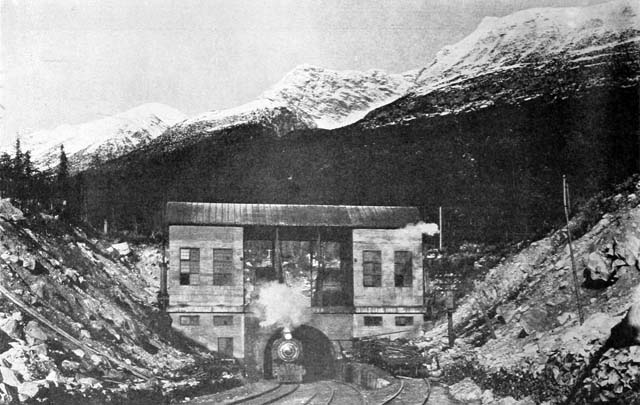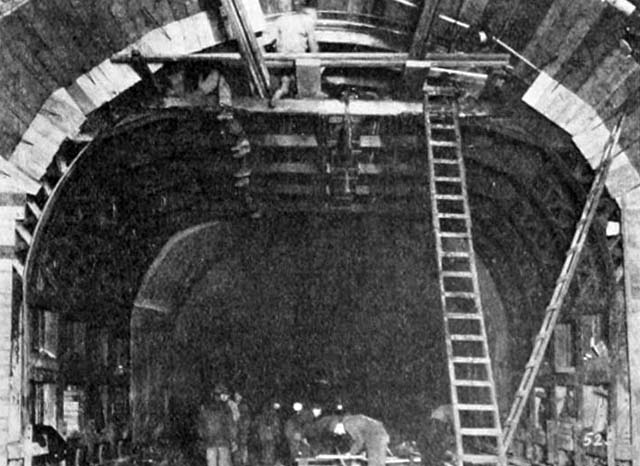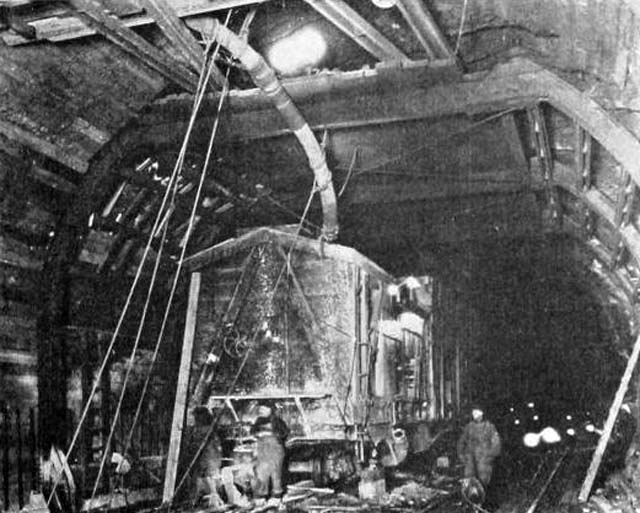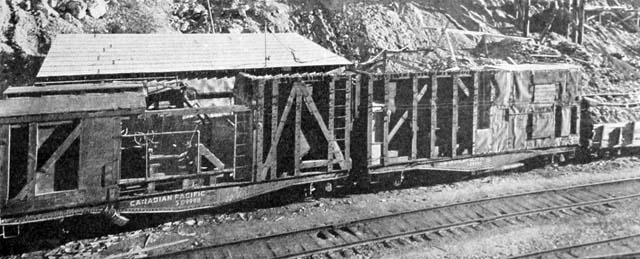|
Portable concrete mixing and placing apparatus.
Lining the Canadian Pacific's
Five-Mile Tunnel
The Connaught tunnel of the Canadian Pacific is located on the main line at Glacier, British
Columbia, about 420 miles east of Vancouver, where it pierces the Selkirk mountains and replaces the old high line over Rogers Pass. The old line had curvature
amounting to about seven complete circles, long and heavy grades, a succession of snowsheds aggregating about five miles in length and an elevation at the
summit of about 4,300 feet. The tunnel reduces the summit elevation by about 500 feet, eliminates all of the curvature and snowsheds, and reduces grades to one
percent against westbound traffic. In a country where the annual snowfall averages ground 40 feet in depth, the advantages arising from the existence of the
tunnel are apparent without much study.
The tunnel itself is a double track-tangent five miles long.
 West portal of the Connaught Tunnel
showing fan house and fans with the Selkirk mountains in the background.
It was opened for traffic in December, 1916, after extraordinarily rapid construction made possible largely by the use of small pioneer tunnels. The later
system consisted of small tunnels driven parallel to and 50 feet distant from the line of the main tunnel with cross tunnels at intervals of 1,500 feet, from
each of which headings were driven each way on the main tunnel line. Materials for the various headings and spoil from the main tunnel were handled effectively
through the pioneer tunnels, as described in the Railway Age of 11 Dec 1914, page 1083.
When the tunnel was put into operation the construction had been carried only to the point of lining a limited portion, particularly that near the entrances,
and of installing a powerful crude oil driven ventilating fan system at the west portal, it being the desire to realize the advantages of the work with the
least delay. Meanwhile consideration was given to lining the balance of the tunnel, about 18,000 feet, in order to effect complete and permanent construction
and to avoid any possible danger of falling rock. The south track of the tunnel was set apart for lining operations and except in this respect it was required
that the lining work should interfere in no way with train movement.
The first consideration therefore was that of providing plant and equipment for installing a concrete lining extending over the entire side walls and tunnel
arch and reinforced with steel, both longitudinally and at right angles to the tunnel section. It was estimated that approximately three cubic yards of
concrete would be required per tunnel foot. At the same time all equipment was to be designed to provide an unobstructed passage for trains, minimize fire and
other hazards, permit normal operation of signals, and to furnish enough light and power in the working zones for rapid and economical construction.
Various combinations of air and electric apparatus were considered, both along the lines of entirely portable, self-contained plants, mounted on cars, and of a
stationary plant located outside of the tunnel. It was ultimately concluded that conditions would best he met by a stationary central electric plant located
outside the tunnel, adapted to supply power to a portable concrete mixing and placing apparatus operating inside the tunnel.
Accordingly, a 300 kilowatt power house was located near the west portal, in which are employed locomotive type coal burning boilers equipped with the
necessary breeching, individual stacks, and blowers. Coal is delivered from standard coal cars running on an overhead trestle. Storage for several hundred tons
of coal for use during the winter months is provided. Feed water for the boilers is obtained from a nearby mountain stream, the delivery being accomplished by
gravity or, in an emergency, by pumps.
Two direct-connected units of 150 kilowatts capacity each deliver power through a simple switchboard from which the power is conducted in two three-phase
circuits of 2,300 volts over a wooden pole line up to the entrance of the west pioneer tunnel. The power is then carried through the pioneer tunnel for about
9,000 feet on bare wire. As the pioneer tunnels, are entirely separated from the main tunnel they provide an ideal space for the stringing of these high
tension lines and have made it possible to effect material savings over the cost of lead covered cables. From the last or sixth crosscut between the pioneer
and main tunnel, the transmission line is carried in cable along the side of the main tunnel for about 3,600 feet to the first working zone. Here the power is
lowered by transformers set in niches in the side wall to 110 volts for light and 550 volts for power. This low tension distribution system is provided with
outlets every 100 feet to which the power and light apparatus can be attached readily.
After numerous experiments had been conducted in connection with the lighting of the working areas and particularly with a view to overcoming the effect of the
smoke following the passage of trains, flood lights of 500 watts capacity each were installed. These lights are portable and can be arranged singly or in
batteries as may be desired.
A phase of the lighting problem equally important to that of providing adequate light in the presence of smoke was that of arranging the system so that the
intensity of the light could be reduced as the smoke cleared away, thus avoiding the blinding effect of excessive light on the workmen. The lights have largely
cut down the time which would otherwise be lost in waiting for smoke to clear. With approximately 125 men working, this loss of time would be a very
considerable item.
The actual mixing and placing of concrete is accomplished by two 715 ton pit flat cars coupled together. On one car there is a 1,290 foot motor-driven
compressor, while on the other car is a motor-driven concrete mixer emptying into a pneumatic placer from which successive charges of concrete are shot by air
under about 80 pounds pressure into the forms. These cars also carry sand, gravel, water, and about 450 bags of cement. All storage of materials on the cars is
calculated on a basis of blowing one complete form or 21 feet 6 inches of completed tunnel without going outside the tunnel for recharging.
In operation, the cars are spotted under the form to be blown, electrical connections made with the power line, and flexible hose projected into the form,
after which the power is turned on and mixing and blowing begun. A 200 horsepower motor is used to drive the compressor but no difficulty has been encountered
from vibration or rocking of the cars in spite of the large capacities of the apparatus placed upon them. A 27 ton gasoline locomotive is used to handle the
cars in and out of the tunnel and to do a variety of switching of material cars from the main line to the various storage bins. This gas locomotive is
supplemented at times by a steam locomotive, particularly during the winter under snow conditions.

Form ready for blowing. Completed tunnel in background.
The concrete is blown into collapsible steel forms, there being six of these units. each giving 21 feet 6 inches of completed tunnel at one setting. These
units are set up, filled, collapsed, and rolled forward to their new position in rotation, the schedule calling for one complete form to be blown every day.
These forms clear all traffic. Each form is preceded by a so-called pioneer form, or movable platform, spanning both tracks from which all advance work is
done, including a considerable amount of overhead work arising from roof scaling, the completing of false forms where the tunnel section is over-broken, the
packing of the space behind these false forms with lagging, and finally the placing of reinforcing preparatory to concreting.

View showing pioneer form and mixing apparatus ready for placing concrete.
Outside the tunnel a camp has been built, complete in all details, as the work is in the heart of the mountains and has to be entirely self-contained.
Bungalows have been erected for sleeping quarters, subdivided into units of four men each. Separate small houses have been built for the married men and there
are also provided a community dining room, bath house, laundry, kitchen, and storehouses, in all about 55 buildings. All quarters are electrically lighted and
provided with water, and the camp includes a drainage system with a septic tank.
Near the power house there is a small motor-driven machine shop and blacksmith shop in addition to sheds for the storage of cement, reinforcing steel, lagging,
and lumber. These are particularly necessary on account of the heavy snowfall which buries everything deeply during the winter. A 5,000 yard gravel bunker
handling its material by gravity is also installed. Steam heat is provided to prevent the gravel from freezing.
This work is being done under the direction of W.A. James assistant chief engineer, Frank Lee engineer maintenance of way, and H. Rindal district engineer of
the Canadian Pacific, Mr. James having previously represented the railway on the ground as engineer of construction in charge of the driving of the tunnel. The
Sydney E. Jenkins Company Ltd., Winnipeg and Vancouver, is doing the construction work. We are indebted to the latter company for this
article.
Anonymous Author.
|




